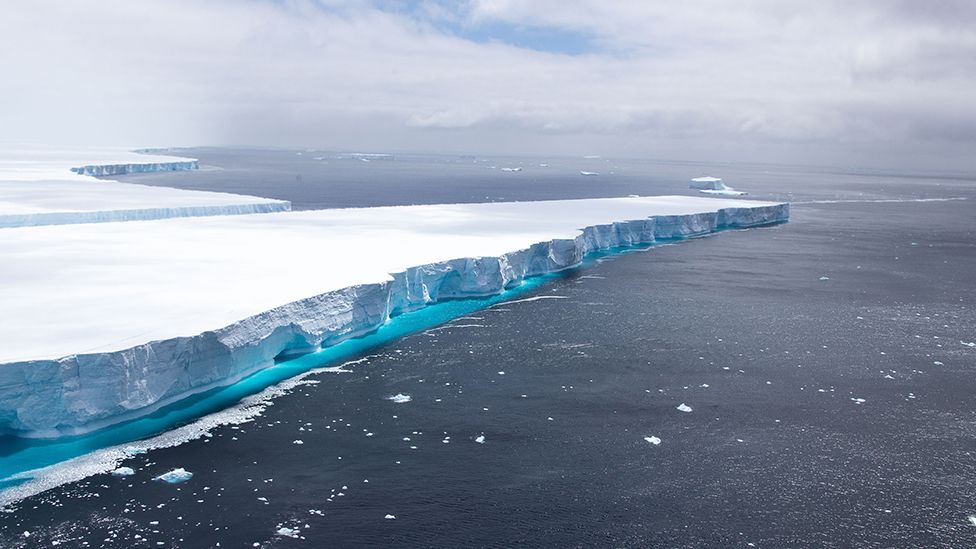A68: World's biggest iceberg has melted away
- Published
- comments

Wide but extremely thin: A68 was about 230m thick on average
A massive iceberg named A68, which was once the biggest in the world and became a social media star, has melted away.
It once covered an area of nearly 6,000 sq km (2,300 sq miles) when it broke away from Antarctica in 2017.
That's like a small country or equal to a quarter of the size of Wales.
But satellites show the mega-berg has now virtually gone, broken into lots of little pieces that the US National Ice Center says are no longer worth tracking.
What happened to the A68 iceberg?
Pointing the way: Viewed from space, A68a has the look of a hand with an outstretched index finger
A68 was calved from the Larson C Ice Shelf on the edge of the Antarctic Peninsula, and for a year it hardly moved. But then it started to drift north with increasing speed, riding on strong currents and winds.
The billion-tonne block moved out into the South Atlantic towards the British Overseas Territory of South Georgia. The small island is where many of the biggest icebergs end up melting away as they get caught in the shallows.
But A68 somehow managed to escape this and was eventually destroyed by the waves, warm water and higher air temperatures in the Atlantic. It shattered into smaller and smaller fragments.
It's amazing that A68 lasted as long as it did
Adrian Luckman, Swansea University
Adrian Luckman, from Swansea University, told BBC News: "If you think about the thickness ratio - it's like four pieces of A4 paper stacked up on top of one another. So this thing is incredibly flexible and fragile as it moved around the ocean. It lasted for years like that. But it eventually broke into four-to-five pieces and then those broke up as well."
Becoming a social media star
The last major fragment, known as A68a, viewed at the edge of an icy slush
A68 was the first iceberg to become a social media star.
People around the world shared satellite pictures online, especially as the frozen block neared South Georgia. Had it grounded there, the berg's immense size could have disrupted the foraging behaviour of the island's many penguins.
"A68 caught the attention of a lot of different people," commented Laura Gerrish, a mapping specialist with the British Antarctic Survey (BAS). "We saw every little twist and turn. We were able to follow its progress with daily satellite images, at a level of detail we've not really been able to do before."
What A68 taught us
The Larsen C ice shelf is formed from glacier ice that has flowed off the land into the sea
The massive iceberg was the subject of some serious scientific investigation.
Researchers used new sensors to get "useful insights...that could not have been 'seen' in the decade before", according to Christopher Shuman from the University of Maryland, Baltimore County (UMBC) and Nasa-Goddard.
A68 told researchers something about how ice shelves form and how they break apart to produce icebergs.
Is climate change to blame?
British Antarctic Survey put robotic gliders in the water to study the environment around the berg. The robot will be recovered in May and should reveal information about how icebergs affect their surroundings by dumping huge volumes of fresh water into the ocean as they melt
Most scientists see A68 as the product of a very natural process. Ice shelves will eject icebergs as a way to balance their mass. As snow and the input of more ice from glaciers on land builds up, ice bergs break off to keep the ice shelf in balance.
So climate change cannot be the sole reason behind how A68 started out.
However, this giant berg did show how warming seas can destroy ice structures.
- Published9 April 2021
- Published19 June 2019
- Published14 April 2021
